Subsidy for the price of Liquefied Petroleum Gas in Bolivia
DOI:
https://doi.org/10.35319/lajed.20031339Keywords:
Subsidy, Liquefied Petroleum GasAbstract
This document analyzes the redistributive consequences of a possible elimination of the price subsidy for Liquefied Petroleum Gas (LPG) in Bolivia. Through a micro simulation procedure, the behavior change that families would have, depending on their level of income and poverty, was studied before an increase in the price of LPG. To achieve this goal, the household survey carried out in Bolivia at the end of 2000 was used.
The most important results are: a) the consumption of LPG is characteristic of urban households, whether they are poor or not; b) the redistributive impact that the elimination of the subsidy would have depends on the ability of these families to replace this energy; therefore, the greater the substitution, the lower the regressivity of the measure; and c) the energy sources that are more likely to be substitutes for LPG are firewood and kerosene. Another impact of the increase in the price of LPG would be the recomposition of the energy matrix, privileging the consumption of these last two products.
Downloads
References
Bolivia. Superintendencia de Hidrocarburos, s.f. Informes Estadísticos Varios. La Paz: Superintendencia de Hidrocarburos.
Bolivia. Yacimientos Petrolíferos Fiscales Bolivianos, s.f. Informes Estadísticos Varios. La Paz. Yacimientos Petrolíferos Fiscales Bolivianos.
Bonnet. Carole y Runan Mahicu. 2000. "Public Pensions in a Dynamic Microanalytic Framework: The Case of France". En Lavinia Mitton, Molly Sutherland y MelvynWeeks (eds.). Microsimulation: Modeling for Policy Analysis. Cambridge University Press.
Bruce, Neil. 1990. "Measuring Industrial Subsidies: Some Conceptual Issues". Department of Economics and Statistics OECD. Working Paper N° 75.
Coate, Stepen. 1999. "An Efficiency Approach to the Evaluation of Policy Changes”. National Bureau of Economic Research, Working Paper N° 7316.
Choe, Chongwoo e Imad Moosa. 1998. “A Dynamic Forecasting Model of Oil Demand in Developing Countries". The Journal of Energy and Development. Vol. 23, No. 2, pp. 195- 206.
Clements. Benedict. Hugo Rodriguez y Gerd Schwartz. 1998. “Economic Determinants of Government Subsidies". FMI. Working Paper N° 166. Diciembre.
Decoster, André y Guy van Camp. 2000. "The Unit of Analysis in Microsimulation Models for Personal Income Taxes: Fiscal Unit or Households". En Lavinia Mitton, Molly Sutherland y Melvyn Weeks (eds.). Microsimulation: Modeling for Policy Analysis. Cambridge University Press.
Dickert, Stacy. Scott Houser y John Karl Scholz 1994. “Taxes and the Poor: A Microsimulation Study of Implicit and Explicit Taxes". Institute of Research Poverty. Discussion Paper N° 1040. Agosto.
Energy Information Administration. 1999. "Federal Financial Interventions and Subsidies in Energy Markets 1999: Primary Energy". Office of Integrated Analysis and Forecasting, US Department of Energy. N° 0.3.
Heckman. James. 1999. "Causal Parameters and Policy Analysis in Economics: A Twentieth Century Retrospective". National Bureau of Economic Research. Paper Series. Working Paper N° 7333. Septiembre.
Hirshleifer. Jack y Amihai Glazer. 1992. Microeconomía. Teoría y aplicaciones. México: Editora Prentice Hall.
Hope, Enar y Balbir Singh. 1995. "Energy Prices Increases in Developing Countries". World Bank Policy Research. Working Paper N° 1442. Marzo.
Ichimura, Hidehiko y ChristopherTaber. 2000."Direct Estimation of Policy Impacts". National Bureau of Economic Research. Paper Series. Technical Working Paper N° 254. Junio.
Kaplanoglou, George. 2000."A Microsimulation Analysis of the Distribution of the Indirect Tax Burden Among Greek Households”. En Lavinia Mitton, Molly Sutherland y Melvyn Weeks (eds.). Microsimulation: Modeling for PolicyAnalysis. Cambridge University Press.
Klevmarken, Anders. 1997. "Behavioral Modeling in Microsimulation Models". Department of Economics, Uppsala University. Mimeo. Diciembre. y 2001. “Microsimulation. A Tool for Economic Analysis”. Department of Economics. Uppsala University. Mimeo. Enero.
Mitton, Lavinia, Molly Sutherland y Melvyn Weeks. 2000. Microsimulation: Modeling for Policy Analysis. Cambridge University Press.
Morales, Rolando. 2000. Métodos para medir la pobreza. La Paz: Editora Universidad Andina Simón Bolívar. Maestría en Políticas Sociales y Desarrollo Humano.
Riedy, Chris. 2001. “Public Subsidies and Incentives to Fossil Fuel Production and Consumption in Australia”. Institute for Sustainable Future. Draft Discussion Paper Mimeo.
Robilliard Anne Sophie, Francois Bourguignon y Sherman Robinson. 2001. “Crisis and Income Distribution: A Micro-Macro Model for Indonesia”. Institute de Recherche pour le Developpement and DIAL. The World Bank International Food Policy Research Institute. Mimeo. Junio.
Saez, Emmanuel. 2002. “Direct or Indirect Tax Instruments for Redistribution: Short Run Versus Long Run”. National Bureau of Economic Research. Paper Series.Working Paper N° 8833. Marzo.
Wright, Patrick. 1996. “Regulation of Petroleum Product Pricing in Africa: A Proposed System Based on Studies of Four Sub-Saharan Countries”. World Bank. Ocasional Paper N° 7. Agosto.






